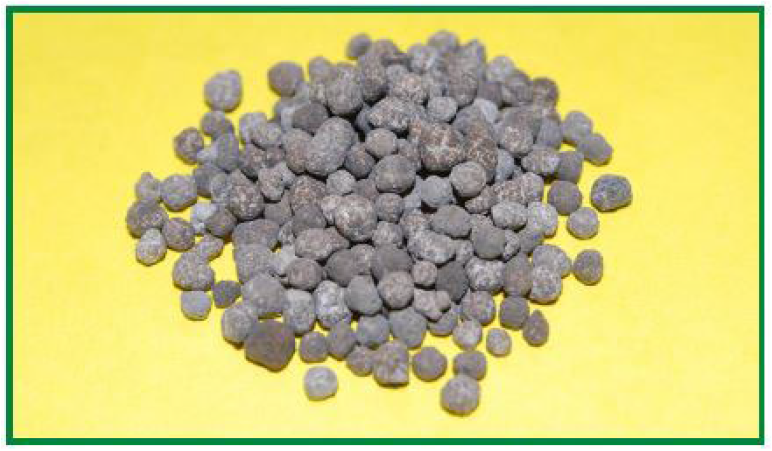⇦ Back to Fertilizer Lime Amendment Technology and Use Home
¶ Introduction
Triple superphosphate (TSP) was one of the first high analysis phosphorus fertilizers that became widely used in the 20th century. It is known as “calcium dihydrogen phosphate” and as “monocalcium phosphate”. Triple superphosphate is an excellent phosphorus source, but its use has declined as other phosphorus fertilizers have become more popular.
¶ Table 1. |
|
| Analysis | 44% - 46% P2O5 |
| Chemical formula | Ca(H2PO4)2•H2O |
| Water solubility | generally > 90% |
| pH (1% solution) | 1 – 3 |
| Bulk density, lbs./cu.ft. | 73 - 75 |
¶ Production
The concept of triple superphosphate production is relatively simple. Non-granular triple superphosphate is commonly produced by reacting finely ground phosphate rock with liquid phosphoric acid in a cone-type mixer.
Granular triple superphosphate is made similarly, but the resulting slurry is sprayed as a coating onto small particles to build granules of the desired size.
The product from both production methods is allowed to cure for several weeks as the chemical reactions are slowly completed. The chemistry and process of the reaction will vary somewhat depending on the properties of the phosphate rock. It is marketed in both granular and non-granular forms.
¶ Agricultural Use
Triple superphosphate has several agronomic advantages that made it such a popular phosphorus source for many years. It has the highest phosphorus content of dry fertilizers that do not contain nitrogen.
Over 90% of the total phosphorus in triple superphosphate is water soluble, so it becomes rapidly available for plant uptake. As soil moisture dissolves the granule, the concentrated soil solution becomes acidic. Triple superphosphate also contains 15% calcium (Ca), providing an additional plant nutrient.
A major use of triple superphosphate is in situations where several solid fertilizers are blended together for broadcasting on the soil surface or for application in a concentrated band beneath the surface. It is also desirable for fertilizing leguminous crops, such as alfalfa or beans, where no additional nitrogen fertilization is needed to supplement biological nitrogen fixation.
¶ Figure 1. Triple Superphosphate (TSP) Form

¶ Management Practices
The popularity of triple superphosphate has declined because the total nutrient content (as N + P2O5) is lower than ammonium phosphate fertilizers such as monoammonium phosphate, which by comparison contains 11% N and 52% P2O5.
Costs of producing triple superphosphate can be higher than ammonium phosphates, making the economics for triple superphosphate less favorable in some situations.
All phosphorus fertilizers should be managed to avoid losses in surface water runoff from fields. Phosphorus loss from agricultural land to adjacent surface water can contribute to undesired stimulation of algae growth. Appropriate nutrient management practices can minimize this risk.
¶ Non-Agricultural Uses
Monocalcium phosphate is an important ingredient in baking powder. The acidic monocalcium phosphate reacts with an alkaline component to produce carbon dioxide, the leavening for many baked products.
Monocalcium phosphate is commonly added to animal diets as an important mineral supplement of both phosphate and calcium.
¶ References
IPNI. Nutrient Source Specifics No. 14: Triple Superphosphate. International Plant Nutrition Institute, Norcross Georgia. 1 pg.